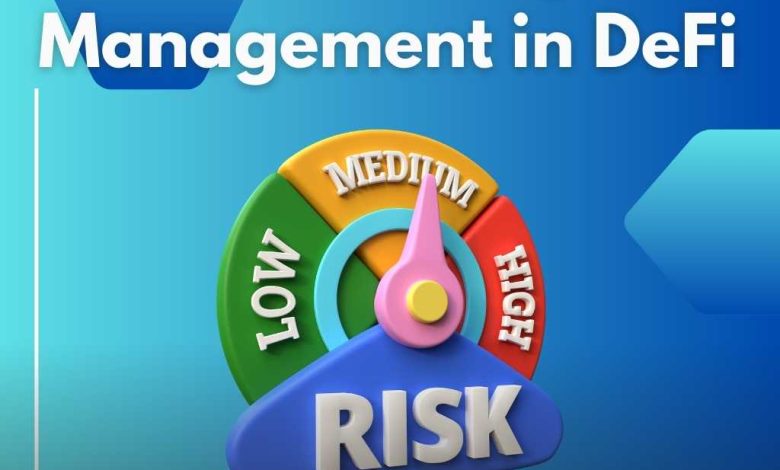Managing Risk in DeFi Investments

- Understanding the Risks of DeFi Investments
- Strategies for Mitigating Risk in DeFi
- Common Pitfalls to Avoid in DeFi Investing
- The Importance of Due Diligence in DeFi Investments
- Diversification Techniques for DeFi Portfolios
- Regulatory Challenges in the DeFi Space
Understanding the Risks of DeFi Investments
When it comes to DeFi investments, it is crucial to understand the risks involved. While decentralized finance can offer high returns, it also comes with a significant level of risk. Here are some key points to consider when evaluating the risks of DeFi investments:
- Smart contract risk: One of the primary risks associated with DeFi investments is smart contract vulnerabilities. Smart contracts are susceptible to bugs and hacks, which can result in the loss of funds. It is essential to thoroughly audit the smart contracts of any DeFi project before investing.
- Market volatility: The DeFi market is highly volatile, with prices of assets fluctuating rapidly. This volatility can lead to significant losses if the market moves against your position. It is essential to be prepared for price swings and have risk management strategies in place.
- Liquidity risk: DeFi platforms rely on liquidity providers to function. If there is a lack of liquidity in the market, it can be challenging to buy or sell assets at a fair price. This can result in slippage and potential losses for investors.
- Regulatory risk: The DeFi space is still relatively unregulated, which can expose investors to regulatory risks. Changes in regulations or government crackdowns on DeFi projects can impact the value of assets and the overall market sentiment.
- Counterparty risk: When participating in DeFi investments, there is always a counterparty involved, whether it be a borrower, a lender, or a liquidity provider. If the counterparty defaults or acts maliciously, it can result in financial losses for investors.
By understanding and carefully evaluating these risks, investors can make informed decisions when it comes to DeFi investments. It is essential to conduct thorough research, diversify your portfolio, and only invest funds that you can afford to lose. With proper risk management strategies in place, investors can navigate the DeFi space more effectively and potentially achieve their investment goals.
Strategies for Mitigating Risk in DeFi
When it comes to managing risk in DeFi investments, there are several strategies for mitigating risk that investors can employ to protect their assets. By being proactive and implementing these risk management techniques, investors can minimize the potential for losses and maximize their chances of success in the volatile world of decentralized finance.
- Diversification: One of the most effective ways to mitigate risk in DeFi investments is to diversify your portfolio. By spreading your investments across a range of different assets, you can reduce the impact of any single asset performing poorly.
- Due Diligence: Before investing in any DeFi project, it is essential to conduct thorough research and due diligence. This includes examining the project’s whitepaper, team members, and community feedback to assess its credibility and potential for success.
- Stablecoins: Investing a portion of your portfolio in stablecoins can help reduce the overall volatility of your investments. Stablecoins are pegged to a stable asset, such as the US dollar, and can provide a safe haven during market downturns.
- Stop-Loss Orders: Implementing stop-loss orders can help protect your investments from significant losses. By setting a predetermined price at which to sell an asset, you can limit your losses and prevent emotional decision-making during market fluctuations.
- Risk Assessment: Regularly assessing the risk profile of your DeFi investments is crucial for identifying potential vulnerabilities and adjusting your strategy accordingly. By staying informed and proactive, you can adapt to changing market conditions and protect your assets.
Common Pitfalls to Avoid in DeFi Investing
When it comes to DeFi investing, there are several common pitfalls that investors should be aware of in order to manage risk effectively. By avoiding these pitfalls, investors can protect their investments and maximize their returns in the DeFi market.
- Overleveraging: One of the most common pitfalls in DeFi investing is overleveraging. This occurs when investors borrow too much money to invest in DeFi projects, which can lead to significant losses if the market turns against them.
- Ignoring smart contract risks: Smart contracts are the backbone of DeFi projects, but they are not infallible. Ignoring the risks associated with smart contracts can result in loss of funds due to bugs or vulnerabilities.
- Chasing high yields: While high yields can be tempting, they often come with high risks. Investors should be cautious of projects offering unrealistically high returns, as they may be unsustainable or even fraudulent.
- Failure to diversify: Diversification is key to managing risk in any investment portfolio. Failing to diversify in DeFi investments can expose investors to unnecessary risk if a single project or sector underperforms.
- Not doing proper research: Due diligence is crucial in DeFi investing. Failing to research a project thoroughly can result in investing in scams or projects with no real value, leading to loss of funds.
By being aware of these common pitfalls and taking steps to avoid them, investors can navigate the DeFi market more effectively and protect their investments in the long run.
The Importance of Due Diligence in DeFi Investments
Conducting due diligence is crucial when it comes to DeFi investments. This process involves thoroughly researching and analyzing a project before committing any funds. By performing due diligence, investors can assess the risks associated with a DeFi project and make informed decisions.
One of the key aspects of due diligence in DeFi investments is evaluating the smart contracts that underpin the project. Smart contracts are self-executing contracts with the terms of the agreement directly written into code. It is essential to review the code for any vulnerabilities or bugs that could potentially be exploited by malicious actors.
Additionally, investors should research the team behind the DeFi project. Understanding the backgrounds and experience of the team members can provide insight into their capabilities and credibility. A reputable and experienced team is more likely to deliver on their promises and navigate challenges effectively.
Furthermore, it is essential to assess the liquidity of the DeFi project. Liquidity refers to the ease with which an asset can be bought or sold without causing a significant impact on its price. Projects with adequate liquidity are less susceptible to price manipulation and volatility.
In conclusion, due diligence plays a critical role in managing risks in DeFi investments. By thoroughly researching and analyzing smart contracts, team backgrounds, and liquidity, investors can make more informed decisions and mitigate potential losses.
Diversification Techniques for DeFi Portfolios
Diversification is a key strategy for managing risk in DeFi portfolios. By spreading your investments across a variety of assets, you can reduce the impact of any single asset’s performance on your overall portfolio. There are several techniques you can use to diversify your DeFi investments:
- Asset Allocation: Allocate your funds across different types of assets, such as stablecoins, cryptocurrencies, and tokens. This can help you spread risk and take advantage of different market trends.
- Industry Diversification: Invest in DeFi projects from various industries, such as decentralized exchanges, lending platforms, and derivatives markets. This can help you avoid concentration risk in any one sector.
- Geographic Diversification: Consider investing in DeFi projects from different geographic regions to reduce your exposure to regulatory and political risks in any single country.
- Token Diversification: Spread your investments across different tokens within the DeFi ecosystem. This can help you take advantage of opportunities in specific projects while reducing risk.
By using these diversification techniques, you can build a more resilient DeFi portfolio that is better able to withstand market volatility and unexpected events. Remember to regularly review and adjust your portfolio to ensure it remains diversified and aligned with your investment goals.
Regulatory Challenges in the DeFi Space
One of the major challenges facing the decentralized finance (DeFi) space is navigating the complex regulatory landscape. As DeFi platforms continue to gain popularity and attract more users, regulators around the world are starting to take notice. The lack of clear regulations governing DeFi projects has led to uncertainty and potential legal risks for investors and developers alike.
Regulatory bodies are struggling to keep up with the rapid pace of innovation in the DeFi space, which has resulted in a patchwork of inconsistent and sometimes conflicting regulations. This regulatory uncertainty can make it difficult for investors to assess the legal risks associated with their DeFi investments, leading to potential compliance issues down the line.
Some of the key regulatory challenges facing the DeFi space include determining whether DeFi platforms should be classified as securities, how to enforce anti-money laundering (AML) and know your customer (KYC) regulations, and how to protect investors from fraud and market manipulation. These challenges are further complicated by the global nature of DeFi, which can make it difficult to enforce regulations across different jurisdictions.




